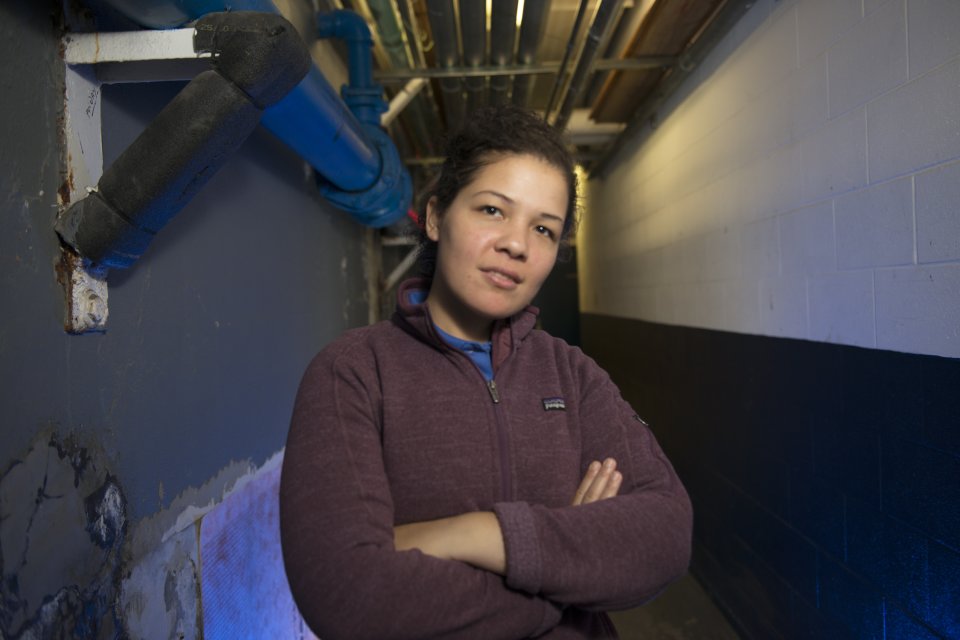
Leading the way on lead poisoning research

Lana Nitti '17 is working to raise awareness in a way that involves--and inspires--local kids.
For residents of Utica, NY, lead exposure is a problem that hits close to home. But for Lana Nitti, an award-winning chemist and Utica College alum, so does the solution.
Nitti’s research began nearly several years ago, when she stumbled upon a USA Today article that explored the lasting damage caused by former lead smelters—the article called them “ghost factories”—in the United States. These plants, despite being long shut down, deposited high levels of lead contamination into the soil, causing major health problems for people, especially children, who live and play in those areas. The article explained that, although researchers have taken their findings to the EPA, the government agency has done little to address the problem.
Intrigued, Nitti, then a student at Mohawk Valley Community College, delved deeper. She found source documents, which listed the precise locations of former lead smelters in New York State—and was stunned to learn that one such “ghost factory” was located almost exactly where she was sitting, in her apartment in Cornhill. She, along with her family and friends, lived in a “red zone,” where lead is at extremely dangerous levels. Nitti went on to learn that the low-income neighborhoods of Cornhill and West Utica have the highest rates of lead poisoning per capita in the entire state.
“I was shocked,” says Nitti. “I thought, ‘My friends and neighbors are being exposed to this poison and they have no idea.’”
After earning her associate degree from MVCC in 2015, Nitti made the decision to continue her research at Utica College. “I wanted to stay close to this issue, and UC offered me the opportunity to do that,” she said. “I explained my goals to Dr. [Curtis] Pulliam, and he was excited to get involved and support me.”
So began a research journey that has earned Nitti numerous awards, including, the first-place prize at the annual Collegiate Science and Technology Entry Program (CSTEP) conference (she also took home the same award in 2015 and 2014). In September 2015, she was invited to share her research as part of TedXUtica, and was also a finalist in the Cards Against Humanity Science Ambassador Scholarship.
Defining the Problem
When children are exposed to lead, a neurotoxin, the consequences can be devastating: lowered IQ, growth and speech delays, learning disabilities, organ failure, and even death. The emotional toll is great—but it doesn’t’ stop there. Students who struggle to learn in school and experience behavioral problems may not earn high-school diplomas or find gainful employment. In fact, recent studies suggest that lead exposure can lead to increases in crime, unemployment and poverty in affected areas.
“It’s quite literally taxing our society,” says Nitti. “We spend more money dealing with the consequences of lead poisoning than we do in trying to prevent it.”
Yet most residents of Utica’s most highly contaminated neighborhoods are completely unaware of the problem. And since many of the areas are home to refugee communities, the language barrier makes it even harder to raise awareness.
“In some languages, there isn’t a word for ‘lead,’” Nitti says. “So explaining the danger of lead poisoning is next to impossible.”
A “Grassroots” Solution
Solving the problem of lead exposure isn’t just a matter of science, Nitti says—it’s a grassroots movement that starts within the community. Modeled after a similar effort in Worcester, Mass., Nitti’s goal is to create a Utica-based program that incorporates middle- and high-school school students by teaching them how to take soil samples in their neighborhoods, then test them in collegiate-level labs for the presence of lead. In the Worcester program, students work with lead-testing kits, which are simple to use, but costly—especially when hundreds of kits are required. Other testing methods, though inexpensive, expose students to dangerous lead levels, can be harmful to the environment, and may be too complicated and time-consuming for young people to grasp.
To address these concerns, Nitti headed to the lab. With help from UC chemistry professors Dr. Curtis Pulliam and Dr. Jesse Crandall, Nitti adapted a method for lead testing that simplifies the process: It involves small soil samples and microwaves (yes, the same ones in most American kitchens). The method, called Microwave Assisted Extraction, allows students to test soil samples in a hands-on way that’s safe, quick, and economical.
The method helps transform lead testing from a complex scientific process to a simple procedure most anyone can do. Nitti’s presentation on MAE wowed judges at April’s CSTEP conference, where she took home first prize in her category.
Next Steps
While Lana Nitti is undoubtedly proud of her MAE research, she’s still focused on the bigger picture: With a simplified and cost-effective testing method, the community program she’s envisioning has a better chance of coming to fruition.
When young scientists get involved in soil testing, she explains, the benefits are twofold: For the community, the increased awareness of the lead issue will encourage parents, landlords, and potentially, the government, to act. And for local kids, exposure to college-level science facilities and real-life chemistry can inspire them to pursue careers in science and technology.
“They’ll see how chemistry affects our everyday lives and plays a role in the community,” she says, “And, hopefully, this will get people talking about the major lead issue.”
For Nitti, the next step is involving local kids through outreach programs and, possibly, acquiring funding through a grant.
"One of the most exciting things was having the opportunity to try my experiment with high-school students from Proctor High School," she says. "The Young Scholars Liberty Partnerships Program invited me to do a weeklong module during their STEM summer program, where I worked with 60 students, having them harvest soil samples from their own yards in Utica and analyze them for lead content. That experience and their feedback helped me grow so much as an activist, educator, and chemist. I think I may have learned more than the kids did! I was also honored to be a 2017 recipient of the Dean Robert Woods Student Life Awards for the contributions of my research in the area of community service."
Her ultimate hope: That the MAE testing method can help areas affected by lead poisoning throughout the country, all while introducing kids to science in a hands-on way.
“I started this with the intention of helping people in my own community,” she says. “But to affect people on a larger scale? That would be phenomenal.”
With plans to pursue a Ph.D. in environmental chemistry, Nitti continues her research well beyond the halls of Utica College and in 2019, she will present the overall results and implications of my research in New Orleans at the National Meeting of the American Chemical Society, which is the largest scientific organization in the world.
More Stories


Students, faculty, and staff ring in the season with annual Holiday Dinner

Utica University Chosen as a Regional Site for Mock Trial National Championship Tournament
I would like to see logins and resources for:
For a general list of frequently used logins, you can also visit our logins page.
